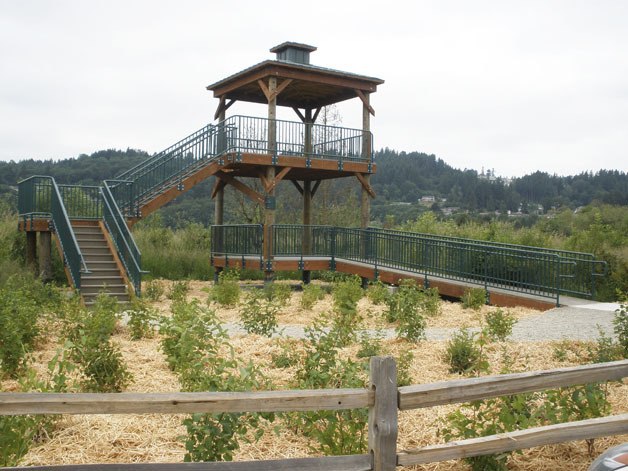Bike paths, parks, organic farms, retention ponds and all-purpose open spaces should make the Auburn Environmental Park District a humming hive of activity.
Making it happen on the 130-acre tract of land between West Main and 15th Street is the goal of a multidisciplinary group of Washington State University students and the City of Auburn.
All efforts aim at reducing waste, reusing energy and managing storm water on the land the City has set aside for sustainable development and green businesses.
The City provided WSU’s Institute for Sustainable Design (ISD) $95,000 for the project. Twenty-one senior architecture students are working with 20 civil engineering and organic agriculture students to develop the plan through ISD’s collaborative Integrated Design Experience (IDeX).
The project will increase the value of the Auburn properties, provide students with hands-on experience and grow high-value green jobs. The master plan for the district also aims to improve the energy and water performance of existing buildings and create a transit-oriented downtown.
Michael Wolcott, professor in the Department of Civil and Environmental Engineering and director of the ISD Deborah Ascher-Barnstone, associate professor in the School of Architecture and Construction Management, and clinical assistant professors in architecture and civil engineering Todd Beyreuther, Karl Olsen and Cara Poor are working with the students to build an engineering, architectural, stormwater management and biological plan for the space.
Adding to the IDeX learning experience, the students will consider the economic and business aspects of their ideas using protocols for sustainable economy developed by cooperating professor Paul Smith of Penn State University.
“The Auburn project is important because of the integrated design component,” said Ascher-Barnstone. “More and more, firms discover that they need to begin projects with all the professionals at the table at the beginning.”
The zoned region of Auburn consists of two wetland areas, two commercial and light industrial areas, and one neighborhood zone. In particular, the students are working to create a sense of unity within these areas.
“My plan is to submerge or elevate the two railroads and open up the space to reunite the city of Auburn as one city rather than three districts” said Hung Ngo, senior architecture student.
“The residential area is a completely dead space because it is surrounded by industrial buildings,” said Ngo. “We want to make the neighborhood more alive by increasing outdoor activity such as bike paths.”
“One of my ideas was to utilize the large amount of parking lots by building a parking garage and using the unneeded parking lots for green spaces,” said Jessalin DeFord, senior architecture student.
The students hope to develop a plan that transforms the suburban districts into a more transit-oriented development by mixing residential and commercial areas to maximize access to public transport.
They still are mulling over the details in order to determine what will take place on each acre, but all potential components work to reduce waste, reuse energy and manage stormwater.
“Some students are looking at ways to diminish noise pollution from the highway and make it visually disappear,” Ascher-Barnstone said. “Others are looking at strategies to retrofit the original building, such as planting green on the roof to absorb more water to keep it from running into the street and make it available for other uses.”
The professors have high hopes for the students and the future of this project that will potentially continue into the spring semester.
“I think the students will be able to imagine some inventive solutions to Auburn’s challenges,” Ascher-Barnstone said.
The students will present their preliminary plans on Nov. 3 in Pullman. IDeX team members from the City of Auburn who will attend the presentation include Rich Wagner, city councilman; Tim Carlaw, Storm Drainage engineer; and Chris Andersen, Environmental Protection Manager.


